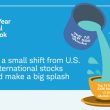by Martin Small, Blackrock
Growth stocks have outpaced the broad market for several years running. Can they continue their winning ways in an economic slowdown? Martin Small poses this question and more to veteran growth investor Lawrence Kemp.
Growth stocks have outperformed their value peers and the broad market in 2019, and have been on a strong run for the better part of the post-crisis period. Is the eventual slowing of economic momentum a death knell for growth stocks, or can they continue to deliver for investors? I recently sat down with Lawrence Kemp, head of BlackRock’s U.S. Growth equity team, to get his outlook.
Martin: Lawrence, growth has had a good run. What I hear most frequently is that it’s unsustainable, it’s a trade. What do you say to that?
Lawrence: It’s true that growth has done well for some time now, but we firmly believe growth stocks are not a “trade.” Growth has become a much more ubiquitous part of the market as companies across all industries implement technology to lower costs and gain market share.
What’s particularly exciting about growth investing today is that, for the first time, we’ve been in an economic environment without a traditional business cycle. What I mean by that is many of the things that may have boosted certain parts of the stock market in the past ― like inflation, interest rates, oil or commodity prices ― are unlikely to provide a meaningful tailwind for equities. And this means investors will seek out companies that prosper organically on their own, almost independent of the economic cycle. I think this will be a good sign for growth stocks overall, not only today but for years to come.
Martin: This isn’t your first rodeo. You’ve seen your share of economic and business cycles over your 32-year career. An expanding economy clearly has put some power behind growth stocks. What happens when economic activity slows?
Lawrence: Let me first say that we do not expect a recession in the U.S. over the next 12 months. Despite elevated levels of market volatility and geopolitical risk, our base case is for a slower but steady economic backdrop in the U.S., benign inflation, and accommodative policy ― all of which can continue to provide a supportive environment for U.S. companies.
So we’re actually optimistic as active growth investors.
Martin: What fuels your optimism?
Lawrence: A combination of slowing economic activity and low inflation means that investors will increasingly seek business models that can work on their own ― independent of the prevailing macroeconomic variables. Companies that are No. 1 or No. 2 in their industry, have pricing power, and can take market share from the competition are what we’re looking for. Our research model is designed to identify these companies early.
Conversely, we don’t want to own companies that rely on the business cycle to do well. We don’t see these business models as likely to drive growth in investor portfolios over time.
Martin: We hear a lot about momentum stocks. Are these the same as growth stocks?
Lawrence: There’s an important distinction. High-momentum stocks are found across different sectors and market capitalizations at different times. We find it very hard to predict what will make up the “momentum” subset of companies at any given point in time. As growth investors, what we’re looking for are positive earnings revisions driven by sales and revenue beats and improving profit margins ― characteristics we believe can propel stock price performance through time. Momentum is very different; it will change rapidly across cycles.
Follow Martin on Twitter.
Martin: Your Fundamental Active Equity colleague Tony DeSpirito recently wrote about the importance of a quality bias today. Is there quality in growth right now?
Lawrence: Absolutely. Where quality resides in the marketplace has shifted meaningfully over the past several years. In the past, consumer staples, utilities and big pharma prevailed as the sought-after quality names in the market. This was due mostly to high returns on capital and low earnings variability.
We have seen a seismic shift in the market. Today, many technology and communication services companies have entered the “quality” realm as they’ve matured. We also believe that certain industries, like payment processors and business services, have emerged as some of the highest-quality parts of the U.S. market. To illustrate, I’d point to Apple, Visa, MasterCard, Facebook and others like them that are highly prevalent in the top-10 holdings of many quality exchange traded funds (ETFs) in the market today.
Martin: You mentioned technology as a potential growth and quality play. Do tech stocks still have room to go?
Lawrence: Tech has outperformed for several years because of the digital transformation taking place across industries. Yet valuations on a cash-flow basis do not appear universally stretched. In fact, tech remains the largest sector weighting in our portfolios. We estimate that the recent annualized spend by enterprises on technology is around $140 billion, and that the total estimated size of spending over the next several years could be in excess of $1.3 trillion globally. This is a massive opportunity for both new and established business models alike. Our challenge is to identify those businesses most likely to capitalize on this historic migration.
Martin: Thank you, Lawrence.
Martin Small is the Head of U.S. Wealth Advisory and a regular contributor to The Blog. Lawrence Kemp is a Managing Director in the Fundamental Equity division of BlackRock Active Equities. He is head of the U.S. Growth team and lead portfolio manager of Mid-Cap Growth Equity Fund, Capital Appreciation Fund and Large Cap Focus Growth Fund.
*****
Investing involves risk, including possible loss of principal.
This material is not intended to be relied upon as a forecast, research or investment advice, and is not a recommendation, offer or solicitation to buy or sell any securities or to adopt any investment strategy. The opinions expressed are as of October 2019 and may change as subsequent conditions vary. The information and opinions contained in this post are derived from proprietary and non-proprietary sources deemed by BlackRock to be reliable, are not necessarily all-inclusive and are not guaranteed as to accuracy. As such, no warranty of accuracy or reliability is given and no responsibility arising in any other way for errors and omissions (including responsibility to any person by reason of negligence) is accepted by BlackRock, its officers, employees or agents. This post may contain “forward-looking” information that is not purely historical in nature. Such information may include, among other things, projections and forecasts. There is no guarantee that any forecasts made will come to pass. Reliance upon information in this post is at the sole discretion of the reader. Past performance is no guarantee of future results. Index performance is shown for illustrative purposes only. You cannot invest directly in an index.
You should consider the investment objectives, risks, charges and expenses of any BlackRock mutual fund carefully before investing. The prospectus and, if available, the summary prospectus contain this and other information about the fund and are available, along with information on other BlackRock funds, by calling 800-882-0052 or from your financial professional. The prospectus should be read carefully before investing.
Prepared by BlackRock Investments, LLC, member FINRA.
©2019 BlackRock, Inc. All rights reserved. BLACKROCK is a registered trademark of BlackRock, Inc. All other marks are the property of their respective owners.
USRMH1119U-1000704-1/1
This post was first published at the official blog of Blackrock.
















